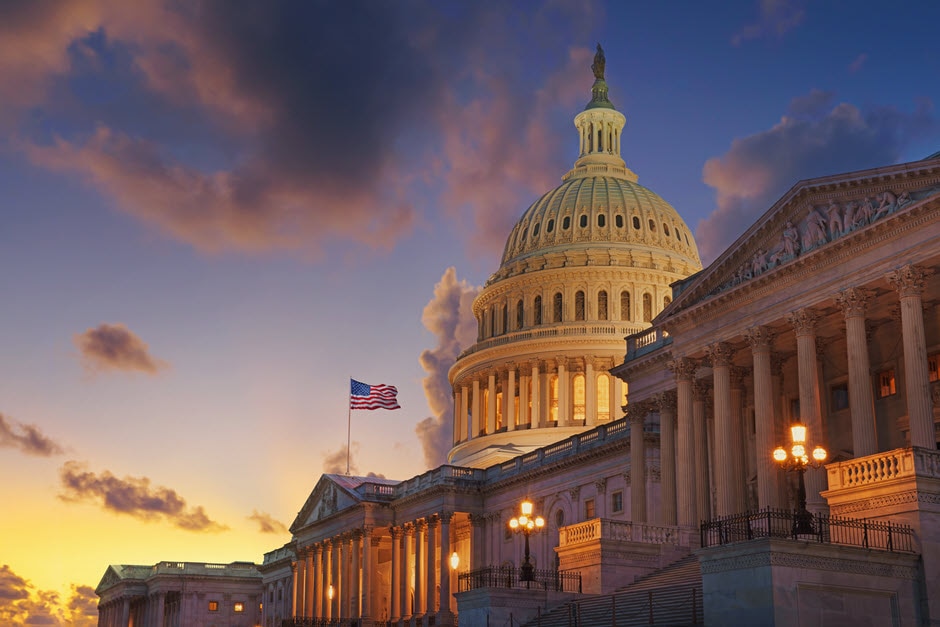Washington Update: Shutdown Fallout, Supreme Court Decisions, and New Tax & Retirement Rules for 2025

The nation's capital is back up to full speed after the longest government shutdown in U.S. history, but the ramifications of the bitter stalemate are likely to linger on. Lawmakers are working now to pass the appropriations bills to fund government operations for the remainder of the fiscal year. Agencies like the IRS, the SEC and the Department of Labor saw their regulatory agendas stalled during the shutdown and will likely be digging out for weeks from a backlog of requests and filings. Meanwhile, the Supreme Court is poised to rule on two cases with big implications for the markets—one on tariffs and one on the Federal Reserve. Here are some of the key issues retirement plan sponsors may want to consider keeping an eye on as 2025 winds down.
Government shutdown fallout
Congress reached a deal on November 12 to re-open the government after the 43-day standoff. The deal temporarily funds all government functions only through January 30, 2026, raising the possibility of a second shutdown early next year. Lawmakers are focusing between now and then on passing the underlying appropriations bills that fund every federal agency and program for the remainder of the fiscal year, which runs until September 30. The re-opening agreement did include three of the 12 full-year funding bills—those for Agriculture, Military Construction and Veterans, and the Legislative Branch. Now Congress is trying to put together a package of four or five more spending bills, including the largest, Defense. Passage of a second set of funding bills would go a long way to averting a partial shutdown in January.
For investors—and the Federal Reserve—the most significant lingering effect of the shutdown is likely to be the lack of economic data. While the September jobs report was released in mid-November, there won't be a traditional October jobs report, marking the first time in 77 years there will be a month without an unemployment rate. Other economic reports will be delayed and could be based on partial information or estimates. Economists believe it's likely to be January before a full picture of the state of the economy is available.
That makes things difficult for the Federal Reserve as it heads into its last monetary policy meeting of the year on December 9-10. After the 25-basis point interest rate cut in late October, Fed Chair Jerome Powell said that another rate cut in December was "not a foregone conclusion, far from it." Comments by Fed governors in November revealed a deepening divide between those who favor a cut and those who favor holding the rate steady. Market expectations of a rate cut in December have plummeted amid real uncertainty about what the Fed will do.
Two giant Supreme Court cases to watch
On November 5, the Supreme Court heard more than 2½ hours of oral arguments in a case that could have profound implications for the president's tariff policy, the economy and global trade. The case focuses on whether the president improperly used a 1970s law, the International Emergency Economic Powers Act (IEEPA), to impose the "reciprocal" tariffs on imports from about 100 countries, as well as some of the tariffs on imports from Canada, China and Mexico. A lower court ruled last May that the president had exceeded his authority, and an appeals court upheld that decision in August. Now the tariffs are in the hands of the Supreme Court, which sounded skeptical of the administration's position during oral arguments. A decision could come as soon as December, but is more likely to be handed down in early 2026.
A ruling against the administration would upend tariff policy and potentially trigger a complicated refund process of more than $100 billion in tariffs paid to date. But it doesn't mean tariffs are going away. The president has other tools for imposing tariffs that he could use, including an emergency provision to impose 15% tariffs for 150 days. And the sector-specific and product-specific tariffs currently in place on steel, aluminum, copper, cars, pharmaceuticals, furniture and other products followed a proper process; those aren't part of the court case and will continue regardless of what the court decides.
Investors might also be keeping an eye on a second Supreme Court case, one with major implications for Fed independence. The court will hear oral arguments on January 21 on President Trump's unprecedented attempt to fire a sitting Fed governor, Lisa Cook. Two lower courts have allowed Cook to stay in her role as one of seven Fed governors while the case plays out. But if the court rules that Cook can be fired, it would mean the end to more than a century of a clear line of separation between the central bank and the White House.
Tax changes coming—and some are already here
Tax code changes made during last summer's "One Big Beautiful Bill Act," will impact just about every American. Several high-profile tax cuts are effective for the current tax year, including no taxes on tip income, no taxes on overtime hours, interest paid on auto loans is now tax deductible, and the special $6,000 deduction for seniors 65 and up, which applies to both itemizers and non-itemizers. All four of those provisions have income caps and other restrictions.
2026 is scheduled to see the increased exemption amount for the estate tax kick in, rising to $15 million per person, a key for estate planning. But one under-the-radar change to the tax code next year is the new floor for receiving a deduction for charitable contributions by individuals who itemize their deductions. Starting next year, that floor will be 0.5% of adjusted gross income, meaning an individual who earns $100,000 and donates $1,000 to a charity will only receive a $500 deduction. Higher earners may want to consider accelerating their charitable donations before the end of 2025 in order to preserve the full deduction.
Retirement savings regulatory outlook
The government shutdown has left the SEC in scramble mode as 2025 winds down. The agency operated with a skeleton staff during the shutdown, as only about 9% of employees were deemed essential to market surveillance. That has left a huge backlog across the agency of paperwork, impacting everything from new adviser registrations to IPOs. It's likely to take into the new year to catch up.
The shutdown also resulted in a pause of the SEC's regulatory activity. SEC Chairman Paul Atkins is focused on reducing the regulatory burden for market participants. The agency last summer formally repealed more than a dozen rule proposals put forward by the previous chairman, Gary Gensler, including rules for investment advisers related to environment, social and governance (ESG) investments, artificial intelligence rules, outsourcing, and cybersecurity. The agency is expected to propose a new version of the Custody Rule in 2026, including clarifications on how custodians should handle cryptocurrency assets.
Over at the Department of Labor (DOL), the top priority remains the August 7 executive order to allow alternative asset investments such as cryptocurrency and private equity in 401(k) and other defined contribution plans. The order directs the details to review past and present guidance, clarify its position on the issues and potentially propose new rules, including "appropriately calibrated safe harbors" to provide legal clarity for fiduciaries. The DOL is supposed to provide an update by February 3, 2026, though it seems likely that date will be delayed given the 43-day government shutdown.
Other items on the DOL's regulatory agenda include updated rules for plan sponsors on using environmental, social and governance (ESG) factors when choosing investment options for a plan. The administration will undo rules from the previous administration, emphasizing that fiduciaries may select investments "based only on financial considerations…not to advance social causes," according to the agenda. The DOL also expects in 2026 to finalize rules related to auto-portability and to the retirement savings "lost and found" database. Also on the agenda is the fiduciary rule. Two courts have stayed the 2024 Retirement Security Rule and appear poised to throw it out entirely, though settlement negotiations are ongoing. It's unclear what steps the DOL will take next. It could rescind the rule and start over or try to rewrite the 2024 rule. Either way, the definition of fiduciary in the retirement savings context remains on the agency's regulatory priorities list with the aim of issuing a new proposal next year, ensuring that the 15-year saga of trying to rewrite the fiduciary rule will extend into 2026 and likely beyond.
Finally, shortly after the government shutdown ended, the Treasury Department announced the 2026 contribution limits for 401(k) plans. Workers will be able to save up $24,500 next year, up $1,000 from the current limit. Catch-up contributions will be $8,000 for employees 50 and over (up from $7,500 this year), and the "super catch up" for workers age 60 to 63 will remain at $11,250. Next year will be the first for the new requirement that workers earning more than $150,000 must put their catch-up contributions into a Roth 401(k) account. This is likely to be a major point of confusion for plan participants, so plan sponsors should be proactive in their communication to affected employees.
 By
By